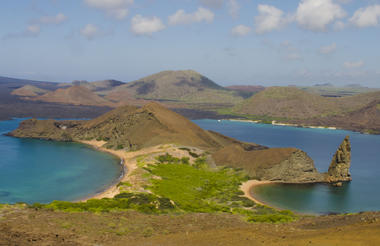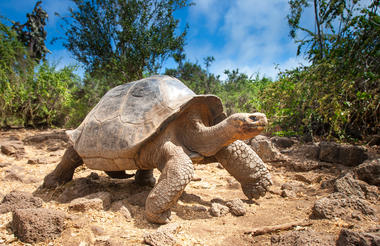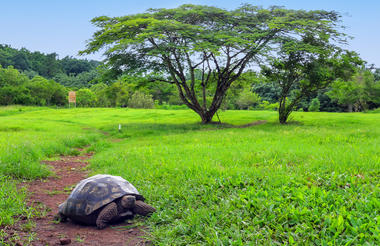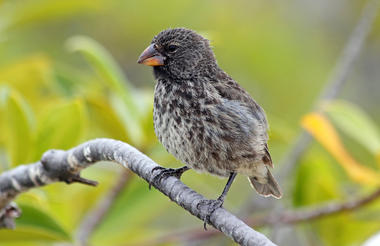Early breakfast, and the day begins with a dinghy ride through Black Turtle Cove, where you can find 4 species of mangrove, and where you will spot turtles, herons, sharks and rays. After this activity, you will be transferred to the airport, to take your flight back to the continent.
Baltra Airport: Departure from Quito or Guayaquil to Baltra Island (2 ½ hour flight). Arriving in
the Galapagos, passengers are picked up at the airport by our naturalist
guides to take advantage of the time in the archipelago.
Punta Carrion (Santa Cruz Island): Dinghy ride at the entry of the Itabaca Channel in a lagoon with turquoise water, where we can observe sharks, blue-footed boobies, and different kinds of fish.



El Barranco Prince Philip´s Steps (Genovesa Island): Be marvelled at the variety of sea life that uses the crevices of the lava cliffs for shelter. Red-billed Tropicbirds fly overhead, switching between their nests and the bay, and a small colony of fur seals may be found near the landing site. You will be dropped off at a steep
stairway that begins on rocks at the foot of a path that leads through a seabird colony full of Nazca and Red-footed Boobies. At the plateau, the trail continues inland allowing you to see more nesting booby colonies in the thin Palo Santo forest. Near the end of the trail, over a rocky lava plain, Wedge-rumped Storm-Petrels can be observed flying in all directions. If you are lucky, you may catch a glimpse of a Short-eared Owl.
Darwin Bay : Disembark onto a small sand and coral beach. A short trail heads west along a tidal lagoon and then up a rocky hill that leads to a point overlooking the cliffs and Darwin Bay. Along the trail near the tidal lagoon, visitors will see pairs of Swallow-tailed Gulls, Lava Gulls, Yellow-crowned and Lava Herons. The trail continues through Palo Santo trees, Opuntia cacti, and Saltbushes inhabited by Great Frigate birds and Red-footed Boobies. This is one of the few places in the islands where visitors are guaranteed to see Red-footed Boobies. It is estimated that more than 200,000 Red-footed Boobies live in the trees and bushes of Genovesa.



Rabida Island : Wet landing. Dark-red sand covers the unique beaches of this island, home of sea lions colonies; Rabida is considered the epicenter of the Galapagos Islands due to the diversity of its volcanic geology. Nesting brown pelicans are found from July through September plus nine species of the famous Darwin’s finches. Here a dinghy ride along marine cliffs is done, to observe nesting seabirds. Snorkel off the coast, where marine life is particularly active.
Bartolome Island : Dry or wet landing. We discover a fascinating landscape formed by different volcanic parasitic cones —lava bombs, spatter, cinder cones — that resembles the moon. Going up to the summit there will be an impressive views of the surrounding islands, including the eroded tuff cone Pinnacle Rock. We also encounter marine iguanas, lava lizards, and blue-footed boobies. Beach time is a great opportunity to do snorkeling and see the famous Galapagos Penguins, sea turtles and White-tipped Reef Sharks among a great variety of colorful fish. For many visitors, this may turn out to be the best snorkeling experience. Crystal clear water is the perfect spot to appreciate the incredible marine life it has to offer. Due to its geographical location, the lack of vegetation is immediately noticeable however, there are pioneer plants including the endemic Tiquilia nesiotica and Chamaesyce (known as sand mat or spurge in English), lava cactus, and Scalesia bushes.



Breakfast
Lunch
Dinner
Highlands: Dry landing. In the mountains of Galapagos is possible to admire different kind of birds, such as: tree and ground finches, vermillion flycatchers, paint-billed crakes, yellow warblers, and cattle egrets (usually standing on the tortoises’ shell). The journey to the reserve offers great opportunities to see the contrasts that the island offers in reference to the variety of ecosystems. The road goes from the coast through the agricultural zone and straight up to the dense humid forests. Often, Galapagos giant tortoises are also seen on the way, wandering through pastures in the paddocks. This spot is a birdwatchers’ haven, since almost every land bird present on the island lives or migrates here.
After the visit, passengers will be transferred to the airport for their return flight to Guayaquil or Quito.



Breakfast








